We flew to Denver and on to Boise (that’s Idaho), whence we drove a rental car 2 1/2 hours east and mostly north to Stanley. The town’s year-round population is just over 100. Its summer function is to be the starting point for rafting trips. We had signed up for a 6-day trip with the Sierra Club on the Middle Fork of the Middle Salmon River.
ADVISORY: Do not undertake this trip if you dislike:
--travelling with strangers;
--setting up (and sleeping in) your own tent every night;
--basic toilet facilities;
--getting drenched in cold water.
The trip was managed by ARTA (American River Travel Association, a non-profit organization). They provided 5 guides, one for each raft. The rafts, heavy rubber, cost about $10,000 each and should last some 16 commercial seasons. Each can fit 6 client paddlers and a paddling guide in back to ensure that all goes well. One of the rafts was for supplies only, while several had oars in back. Yes, they can flip over, but this happens only rarely. There were 16 clients, including the Sierra Club leader who was an emergency room physician. There were some nurses, and another doctor. This was useful, as Susan had prepared for the trip by lacerating her heel on an apartment door.
Here’s the drill: wake up around 7:00, as the sun struggles to lift itself above the high canyon walls on the east. Have breakfast (like all meals, prepared by the guides). On the water by 9:00 or so. Pull over for lunch around noon. Reach camp site between 3:30 and 5:00. Set up tents. Have supper. Sleep.
The distance from Stanley to take-out at Salmon is just under 100 miles. In high water, it can be done in a single day, but what’s the rush? Our daily mileage ranged from 6 miles to 29. Camp sites along the bank are assigned by the Park Service, in order to maintain space between the several rafting groups on the river. Most of the time, you feel as though the entire river were yours alone. There are four ways to travel, in descending order of strenuousness:
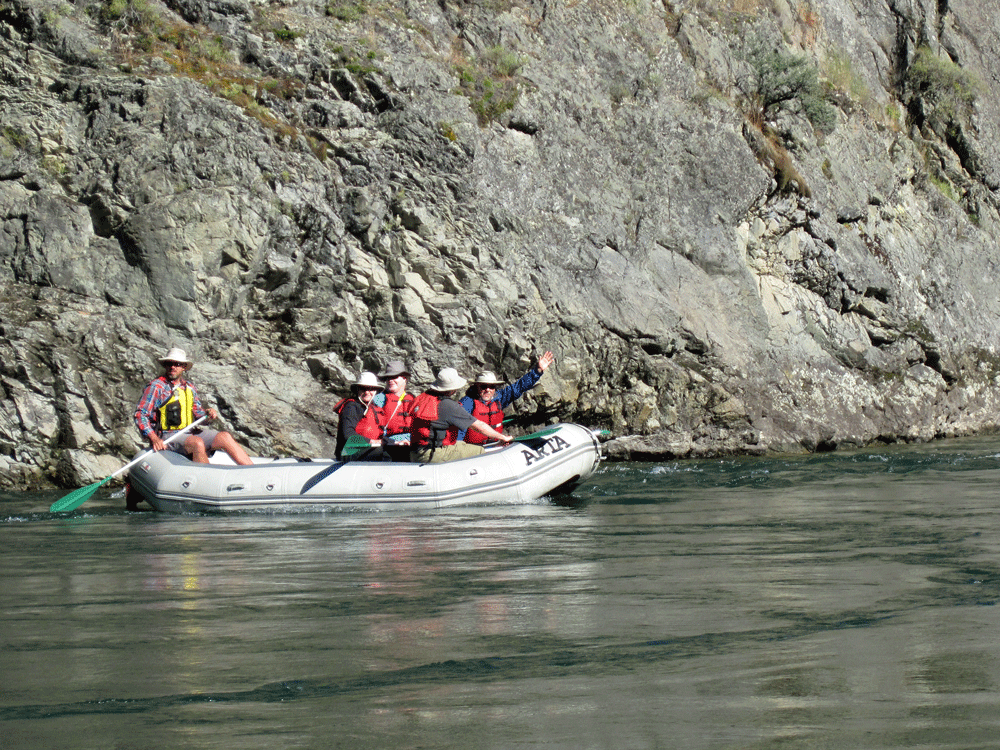
1) Sit in front of a raft while the guide rows;
2) Paddle while the guide rows;
3) Paddle while the guide paddles from the stern;
4) Go it alone in an inflatable kayak.
We skipped #4. Most of the time we chose #3. I got in front, where the drama is greatest. In the rapids, you see great white waves churning in wait for you. You probably won’t fall in, but you will get very wet. If you do fall in, your raft mates will retrieve you quickly. Although intimidating, the rapids were not very technical: no tricky turns or major rocks. You just paddle straight through. The highest rating, given the moderate water level, was 4. (These categories run up to 6. One description: “Don't even think about it! These constitute waterfalls and other death-traps that should not be attempted.”)
Although we were mostly on the river, there was time for the occasional hike. The most spectacular was a brief but steep ascent to a waterfall, which dropped (rather thinly) over an enormous canopy 300 feet above.
We had brought our small tent, which we tested on our roof before departure. But it didn’t seem happy in the wild, where it looked like a big, depressed tortoise. We tried to improve it with duct tape. One of the guides walked by.
“Is something the matter with your tent?”
“Oh no, it’s fine.”
“We do have a spare rental tent, you know.”
The next night we had our one storm--thunder and scary wind. The tent almost blew away, with us inside. We had fortunately ignored our pride and taken the rental tent. The rest of the time the weather was lovely, with cool mornings and pleasantly warm afternoons.
The ethic is to leave nothing but footprints. Every bit of unconsumed food was rafted out as garbage. Same for solid bodily waste. The latrine was a bucket enclosed in a metal box. Atop was a wooden toilet seat. This was a recent addition: previously you just sat on the rim of the box. This arrangement was named “ The Groover,” because of its anatomical impact. The contraption was established near the river edge, so you had great views of any passing rafters, and they of you. Liquid waste was personally delivered into the river.
On the sixth day, right on schedule,
we reached the take-out point at Salmon. The town is populous by local standards--about 4000. We stayed at the Stagecoach Inn and had a farewell dinner with our river mates.
The next morning, on our own once more, we drove north in our rental car. It had been shuttled from Stanley for $95. While we were on the river, it was sitting in a parking lot accumulating rental charges. We put it to work by driving 250 miles to Whitefish, Montana, where we spent two comfortable nights at the Hidden Moose Lodge (delicious breakfasts). We had an excellent dinner at the golf club’s restaurant, where we had made the necessary reservation. We returned to the Lodge by last light, nearly 10:00 p.m. The next day we finally got some lower-body exercise by hiking up Big Mountain. Very beautiful, but so was all the scenery on this trip, so I’ll stop saying it. It’s 2100 feet up to the 7000-foot peak. Never steep, but consistent, and hot in the treeless sections. So we were happy to have a huckleberry shake in the summit house. This structure supports the teleferique that bustles with skiers in winter. We were quite willing to ride it down. The fare was $5.00 for Susan; nothing for me, because I am a “super senior.” We finished the day with a swim in lovely, cool Whitefish Lake, plus a pizza.
It was time to drop our car at the nearest airport (Kalispell) and taxi north to the west edge of Glacier National Park. We stayed at the Belton Chalet, a traditional old place with lots of atmosphere. It was, hover, noisy because thin-walled, and the service was uneven; so we can’t fully recommend it. It does have an excellent restaurant.
The next morning, 6:15, we met our leader for a 6-day expedition in the park. She was Jennifer Buls, a peppy 31-year-old from (relatively) nearby Great Falls.
There were five other clients, all American, as were almost everyone else we met, except Canadians. In the glory days of railroads, Glacier Park had nine chalets. Only two remain. We spent two nights at each. We reached the first, Sperry Glacier Chalet, on horse back. The horses were all geldings--to reduce the “drama,” the wranglers told us. By early afternoon they had got us up the 4.7-mile trail to the chalet. It is a relatively luxurious place (Susan says not). The dining room serves big breakfasts and 3-course dinners to the 50 guests. Latrines (4) occupy a separate building. Sleeping quarters are basic. A waterless and unelectrified wood structure rooms sleeping four. The walls are so thin that free ear plugs are on offer. If you do visit the bathroom at night, expect to encounter goats. They look for salt anywhere, including in urine.
The chalet has nine employees, and the ambience is chummy. Each of the nine makes a few after-dinner suggestions, like Watch out for the bears. They also quiz the guests: “So, young man [about 10], how did you enjoy your hike to the Sperry Glacier today?”
“It wasn’t worth it.”
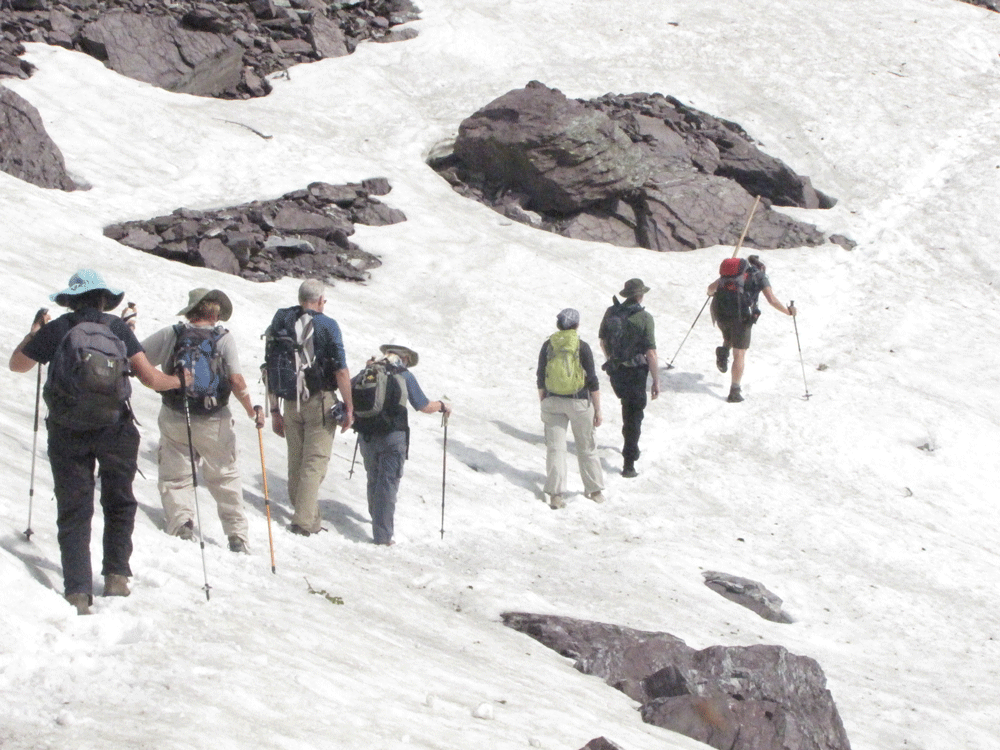
We had arrived early enough for a short hike, which featured a stumbling fall by one of our number. Jennifer said this was the first such episode in her 11 years of guiding. It did make us wonder how strong a group we would be. Just as we returned to the chalet, a thunderstorm crashed in. It was brief but violent, and deposited enough hail for someone to construct a six-inch hailman.
Our big hike started the next morning: zig-zigging across a big canyon to a high saddle. The trail was fairly steep, and intermittently snow-covered. The snow was negotiable in boots; but remembering the previous day’s slip, Jennifer had brought a long-handled shovel to make really big steps. Behind us came a couple with two teenage sons. The mother was wearing running shoes, which were unhelpful on the snow. She kept sensibly resolving to turn back, but the family urged her onwards. After about three hours they--and we--reached the saddle. It gave great views of snow and mountains on the far side. We ventured another half mile for a view of the Sperry Glacier, one of the 25 remain in the park. As recently as 2000 there were 38. In the 19th century, 150. One forecast is that by 2020 they will all be gone.
The following morning we went down to the valley, without horses, and spent a night of comfort in the Belton Chalet. Then Jennifer drove us up the famed Going-to-the Sun Highway. It is well-paved but vertiginous, and often under major repair. From Logan Pass we hiked 7.6 miles to Granite Park Chalet. The trail is mostly level but not free of hazard. The previous day two teenagers had been injured by rock fall. The Chalet commands a gorgeous view. It resembles Sperry, but is more basic. You cook your own meals, which meant that Jennifer had a heavy pack. Without apparent effort, she produced a tasty stir-fry with shrimp and cous-cous.
Weather next day was cloudy and damp, but we hiked anyway. Views were intermittent but large and spectacular. The next morning was entirely clear. We followed the short but steep trail to the Grinnell Glacier lookout. The far side falls off steeply onto the glacier, which lies in a great cirque of rock. It was very windy.
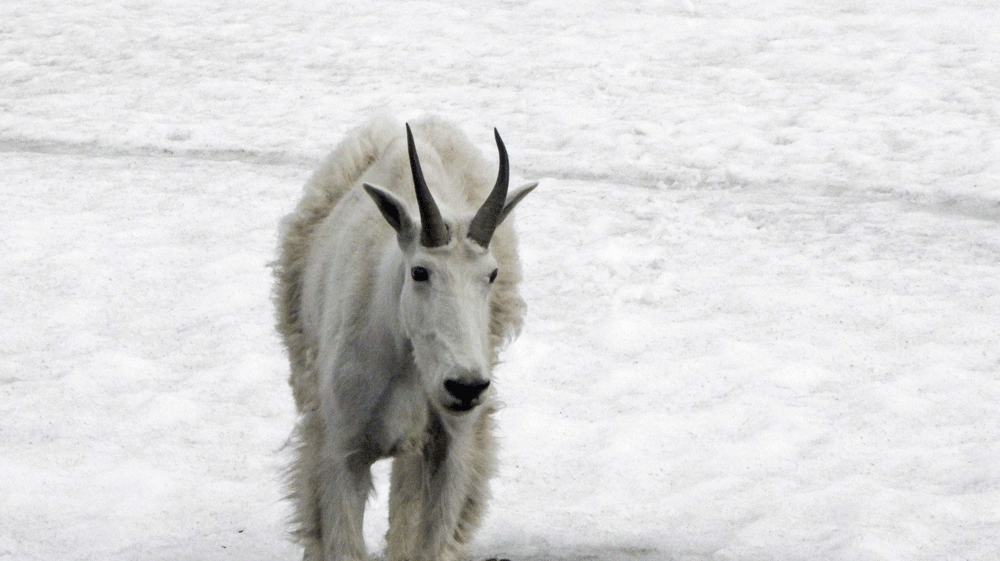
On this sixth and final day we hiked out to the highway on a steep trail that we are happy not to have climbed up. Jennifer had discovered that for two of us, this was birthday. She somehow produced a large cake which we consumed on a secluded shore of Lake Macdonald.
After a final night at Belton, enlivened by the key breaking off in the door of our room, we rented another car. We drove up Going-to-the sun, this time the entire 50 miles to the other (east) side of the park. Thence north a few hours to Waterton, the Canadian extension of Glacier. This may be the most gorgeous place of all. Waterton Lake, another of the long deep glacial bodies of water we had seen, is surrounded by mountains. Dominating an abutment at its north end is the Prince of Wales hotel, an enormous Edwardian construction. Susan had always wanted to stay there, but we settled for high tea. It was only $30 each. That was Canadian currency, but the dollar there is almost equivalent to ours (it used to be 65% or so).
Where to hike the next day? Crypt Lake was enticing: boat ride across the lake, followed by “4 spectacular waterfalls” and a ladder and mountain tunnel. The experience was described as “harrowing,” and Susan vetoed it. Instead we took the boat south to the far end of the lake. About half way through we were in American waters--our easiest border crossing ever. If you stay on the boat we are excused formalities; but if, like us, you want to get off and walk, you must bring your passport. Ours are now stamped “Port of Ghost Haunt, MT,” with an emblem of a mountain goat. The hike to the Kootenai Lakes was flat and took little more than an hour. We did see, across the lake, our first black bear. We were excited, but glad it was no closer: see note below about bears.
Waterton is a pleasant, tourist town on the lake. In winter it is almost deserted, but the shops and restaurants are busy in summer. Deer move about like pedestrians, oblivious of humans. But don’t mess with them, as they can really kick. Their toilet habits are undisciplined.
We had one last hike in the area: 4.2 miles up to Lake Bertha. The latter part climbs 1000 feet, so you get your aerobic. The lake is small but spectacular, cradled in a high cirque.
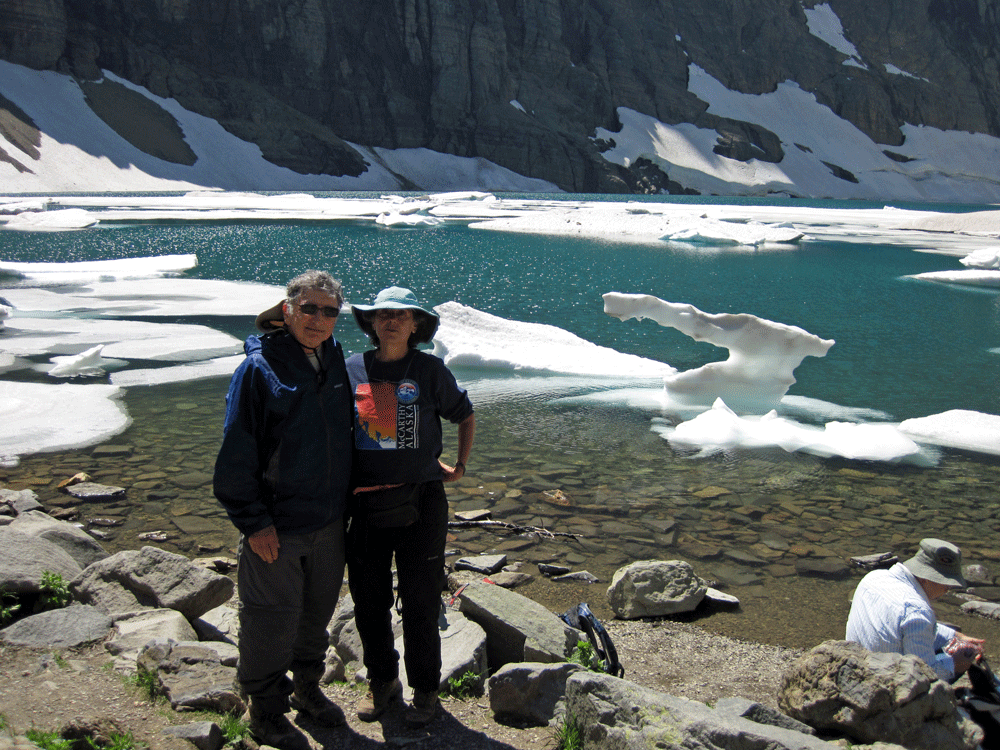
Last stop back in Montana, at the village of St. Mary. We had a comfortable little cabin called Flat Top, in between Curly Bear and Single Shot. We did one more hike in Glacier: 4.7 miles up to Iceberg Lake. The trail was crowded. When we reached the lake we understood why. It really does have icebergs, albeit very small ones, that have broken off the surrounding snow slopes. The rock walls are very steep, but of poor quality for climbing.
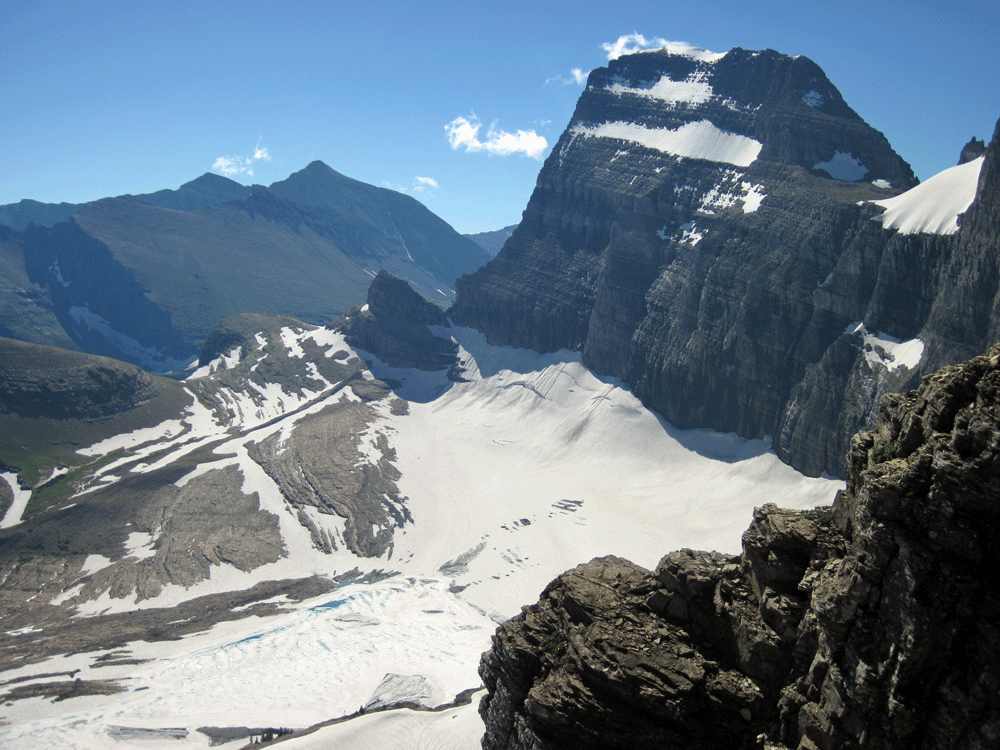
That night we drove a few miles north for dinner at the famous Two Sisters Cafe. There Susan finally had a glass of Moose Drool (it’s beer--quite good, actually). The cafe is cluttered with foreign devices, including a long string of Nepali prayer flags. As we entered, two burly, bearded very Montana-looking men told us they were Armenian. To be safe, I said that we had never been to Turkey, did not want to go to Turkey, did not even know where Turkey was.
Bears: Jack Olsen’s book, The Night of the Grizzlies, describes two fatal attacks in Glacier one night in 1967. One of these was in the Granite Park campground, only a few hundred yards from the chalet. As I recall, Olsen’s thesis is that people and bears cannot really inhabit the same terrain. The Park Service contends otherwise and tries to make peace between the species. When there is a conflict, it is the bears that are favored; if bears have been active on a trail, the trail is closed until they have gone away. To be sure, they do not always make their presence known. Although usually not aggressive, they dislike surprises. In poor visibility you are therefore advised to repeat “Hello, bear” in a firm but friendly voice. If you do sight one of these creatures, avoid eye contact and back off slowly while making small talk. If despite this the bear comes after you, it is time to ready your pepper spray bear deterrent, which you are carrying on your belt for quick access. Wait till Smoky gets close. Don’t spray into the wind. Do not run away. The bear is much faster than you are.
After three weeks on the road, water, and trail, we boarded the Amtrak Empire Builder. East-bound, the train starts in Portland and Seattle and arrives in Chicago 45 hours after. At least that’s the plan. By the time it reached our stop, East Glacier, it was already two hours behind schedule. There was talk of making up the time--a tail wind, perhaps? In fact, we lost another hour or two, but still had a pleasant time of it. It was less luxurious than the Ghan (see: Australia), but reasonable comfortable. Our compartment had two facing seats. Toilets were at the end of the carriage. Meals were adequate, though not memorable. For the night, the compartment became two beds, upper and lower. The former, which I occupied, took some struggle to access. It was, however, comfortable once you got there. We reached Chicago in good spirits, stayed overnight with a friend of Susan’s, and flew on to NYC
--July, 2010